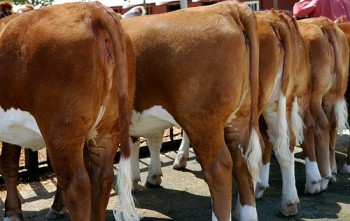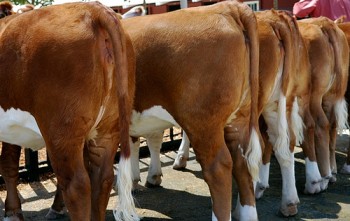 It’s a greenhouse gas, gas, gas!
It’s a greenhouse gas, gas, gas!
As Congress gears up to consider climate legislation, agribusiness is getting sweaty palms — and for good reason.
A landmark 2007 FAO study credited industrial meat production with nearly a fifth of global greenhouse gas emissions — a higher proportion than transportation. Here in the U.S., industrial meat may contribute an even higher portion of total GHG. For example, we produce a fifth of the globe’s chicken and more than half of its turkey, according to one source. We also churn out prodigious amounts of pork and beef.
Meanwhile, evidence is mounting that industrial agriculture may contribute significantly more to climate change than was previously thought. A recent paper (PDF) published by the International Council for Science’s SCOPE offshoot concludes that emissions of nitrous oxide are likely significantly greater that then the levels assumed in earlier assessments. Nitrous oxide is a greenhouse gas nearly 300 times more potent then carbon; and industrial farming, with its heavy reliance in synthetic nitrogen fertilizers, is by far the largest emitter of nitrous oxide. According to the SCOPE report, scientists — including researchers for the International Panel on Climate Change (IPCC) — have long assumed that about 1 percent of nitrogen fertilizer enters the atmosphere as nitrous oxide. But new research claims that 4 percent or as much as 5 percent of nitrogen fertilizer becomes nitrous oxide — meaning that old estimates may be dramatically under counting agriculture’s role in climate change.
This will not be welcome news to the U.S. agribusiness sector. Our biggest crop is corn — a heavy nitrogen feeder. Corn fattens the food industry’s cows, chickens, and pigs, sweetens its sodas and pastries, and generally shows up in nearly everything on the supermarket shelf. And for reasons that no one has ever successfully explained to me, it even increasingly powers oor cars! Here is The Economist reacting to the findings:
Maize, in particular, is described by experts in the field as a “nitrogen-leaky” plant because it has shallow roots and takes up nitrogen for only a few months of the year. This would make maize (which is one of the main sources of biofuel) a particularly bad contributor to global N2O emissions.
Ouch.
Perhaps anticipating draconian fines if serious climate legislation passes, the agribiz lobby has rolled out its climate agenda. It’s a doozy. Honestly, I’ve seen nothing more brazen since AIG execs started stuffing their trousers with government cash after they had made the world’s biggest insurance company a ward of the state. The first two of the “Nine Principles for Climate Legislation” say it all:
1. The agriculture sector must not be subject to an emissions cap.
2. Any cap-and-trade legislation must fully recognize the wide range of carbon mitigation or sequestration benefits that agriculture can provide.
In other words, screw the cap — just give us the trade!!!
Now, societies are going to face serious decisions around food production as climate change proceeds apace. But behaving as though there’s no limit to the emissions that get spewed out to feed ourselves gets us nowhere. A better strategy might be to force agribusiness to pay up for the messes it creates — and give farmers incentives to move to more diversified systems that actually store carbon and eliminate or minimize synthetic fertilizer use. Too bad it’s the scrappy Rodale Foundation, and or Congress, that’s pushing that approach. As Meredith Niles reported here recently, the Waxman/Markey bill now under consideration exempts ag from a GHG cap.



